Abstract
The field of study of sustainable development has gained some popularity among researchers, authorities, corporations. The increase in its popularity is due to the increased attention to the rational use of natural resources in the conditions of an ever-growing population of the planet. This article analyzes publications on the topic of limitations of urban development in such areas as transport, housing. The article shows the positive and negative sides of gentrification on the example of the city of Sochi. As part of the consideration of the labor and real estate market in the city of Sochi, as well as on the basis of data on the construction of houses for a time period of 70 years, a forecast was made about the limits of extensive economic growth of the city. The results of the analysis show that the city has almost exhausted its land resources for housing construction. At the same time, the increasing popularity of the city with the support of supply restrictions in the housing market causes a large increase in prices, which is a multiple of the growth rate of income of local residents. Based on the analysis, proposals are formulated to improve the situation in the housing market for the transition of the city's economy to the rails of sustainable development within the framework of the formulated concept adopted by the UN resolution.
Keywords: Average income, gentrification, redevelopment, real estate market, sustainable development
Introduction
The relevance of the topic is due to the fact that recently the topic of sustainable development has gained some popularity among researchers, authorities, corporations. The increase in its popularity is due to increased attention to the rational use of natural resources in the conditions of an ever-growing population of the planet, exceeding the growth rate of the collection of basic crops, increasing the formation of production and consumption waste per capita (Jinhui et al., 2019). Within the framework of the social sciences and humanities, sustainable development is understood as an evolutionary process in which human potential increases in terms of creating new structures, solving problems, adapting to continuous changes and purposeful and creative striving to achieve new goals (Mensah, 2019). As noted by Sheikhnejad and Yigitcanlar (2020) in a rapidly populating, urbanizing and industrializing human civilization era the anthropocene, sustainability of urban and rural areas is critical to secure the continuum of our existence on the planet. Cities are important from the point of view of the place where it is necessary to change economic processes in order to achieve sustainable development goals. 75% of the population lives in Russian cities. And the role of the city as a place of economic change is great. Within the framework of the Sustainable Development Goals, there are 11 goals, which states that it is necessary to ensure universal access to adequate, safe and affordable housing, expand the scope of open and environmentally sustainable urbanization and opportunities for integrated and sustainable human settlements planning and management. However, migration flows to some Russian cities have increased in Russia in recent years, which has increased the cost of living in these cities so much that local residents cannot afford to live in their own city due to low incomes and constantly rising real estate prices. There is also the problem of having a limit to the ecosystem of the city to withstand a certain number of people. In order to follow the concept of sustainable development, it is necessary that such a large number of people live in cities so that the ecosystem of the city territory can serve this population without using the mechanism of ecological debt.
Problem Statement
Gentrification processes have been taking place in Sochi since 2014. Gentrification is the process of reconstruction (revitalization) of decayed urban neighbourhoods through landscaping and subsequent attraction of wealthier residents (Shilina & Stepanova 2019). If there are positive sides to this process, it is impossible not to note the negative sides. This process in the city of Sochi has become so rapid that the life-supporting infrastructure being created simply cannot withstand such a volume of constantly living population. If we talk about the formation of the city on the rails of sustainable development, then it is necessary to approach the organization of the living space of the city wisely, without forgetting about the natural environment. Traffic jams have become one of the problems of the city as a result of the relocation of a large number of people. Cooke and Behrens (2017) in their article note that in the absence of the possibility to extensively increase the lanes for public transport, it is necessary to distribute the population more or less evenly within the urban space, while it is necessary to take into account the objective limit of the possibility of public transport and transport infrastructure as a whole. The second reason that shows the negative side of the denitrification processes is the situation with the real estate market. In the city of Sochi, the cost of real estate and rent for housing is growing every year. As Glaeser et al. (2020) points out, gentrification is harming local residents by increasing rents and eliminating old amenities, including local shops. As a result, local residents lose their benefits and become much poorer, which goes against the concept of sustainable development. The need to create a sustainable and stable housing market, to which both local residents and migrants should have access, is noted in the work Kauškale and Geipele (2019). In her opinion, the housing market plays one of the most important roles in achieving sustainable development. To give importance to the real estate market, the author proposed to create a separate subsection in the sustainable development strategy of Latvia dedicated to the real estate market.
The last problem caused by gentrification in the city of Sochi is the question of the city reaching the limits of its growth. To date, the city has exhausted its land potential for extensive development. Difficult hilly terrain is an additional constraint when building housing. In order to settle a large volume of the arriving population, it is necessary to clearly zone the territory and identify the impoverished growth points. Gutiérrez and Kahhat (2022) confirm that zoning is a limiting factor for urban growth, and despite the overall potential for growth, some areas are closer to their limit than others. At the same time, M. Gutiérrez notes that urban areas accumulate secondary resources, which in the future may become part of the so-called "urban mines". Also, the existing housing stock determines the natural limitations for the extensive growth of the housing stock in the formed areas.
Research Questions
In course of the study the following questions were raised:
- Has Sochi reached the limit of extensive development of housing infrastructure?
- What measures should be proposed to increase the affordability of housing in the city of Sochi within the framework of the concept of sustainable development?
Purpose of the Study
The purpose of the study is to develop recommendations for ensuring sustainable socio-ecological and economic development of the city of Sochi within the framework of increasing housing affordability based on the analysis of the labor market and real estate.
Research Methods
Authors used the universal scientific research methods as well as methods for comparative and statistical analysis.
In order to determine the composition of the recommendations, it was decided to take a large historical period of analysis of the city's housing infrastructure. To estimate the number of houses built at a certain time, the following groups were formed: built before 1950, 1951-1969, 1970-1989, 1990-2010, 2011-2020. These time series were selected based on the rate of construction (number) of houses in different time periods. Each period differs in the absolute construction of houses, except for the period 1951-1969 and 1970-1989, when the number of houses being built was approximately the same.
The housing infrastructure of Sochi is characterized as follows: 63% of the housing stock was built in the period from 1950-1989, while in the period from 1970 to 1989 there was an increase in the commissioning of square meters of housing by 2.3 times with an increase in the construction of houses by 17% compared to similar periods earlier. At the same time, it is at this time that the highest indicator of housing commissioning is observed. Such a significant increase in the number of square meters is due to the fact that the number of floors of the construction of an average apartment building has increased. The structure of houses in the city of Sochi is shown in Figure 1.
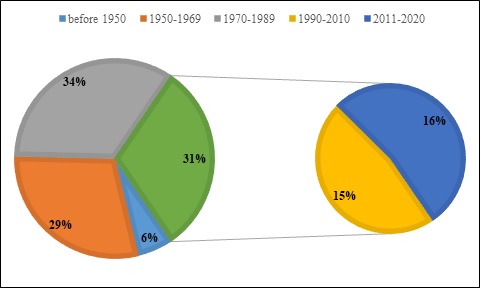
Based on Figure 1, it can be seen that the structure of houses in Sochi is such that 6% - houses built before 1950, some of which are recognized as the cultural heritage of the city (the House of General Soldatenko), 29% - Khrushchev, 34% - Brezhnev, 15% - houses built in new Russia, 16% - new houses.
For all the time under study, there has been a positive increase in the number of square meters of housing relative to the number of houses being built. The ratio of the number of square meters entered and the number of houses erected is shown in Figure 2.
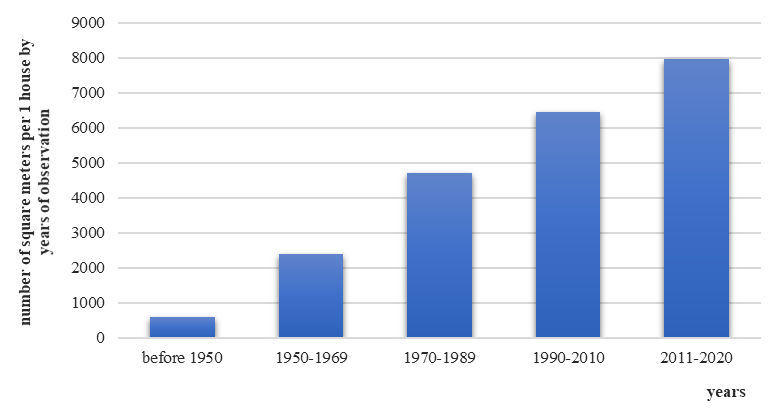
As can be seen from Figure 2, the largest increment in the introduction of housing is observed in the period from 1970-1989. However, the construction of the houses themselves has decreased by more than 2 times. The dynamics of the increment of the input of square meters in apartment buildings is steadily decreasing (Figure 3).
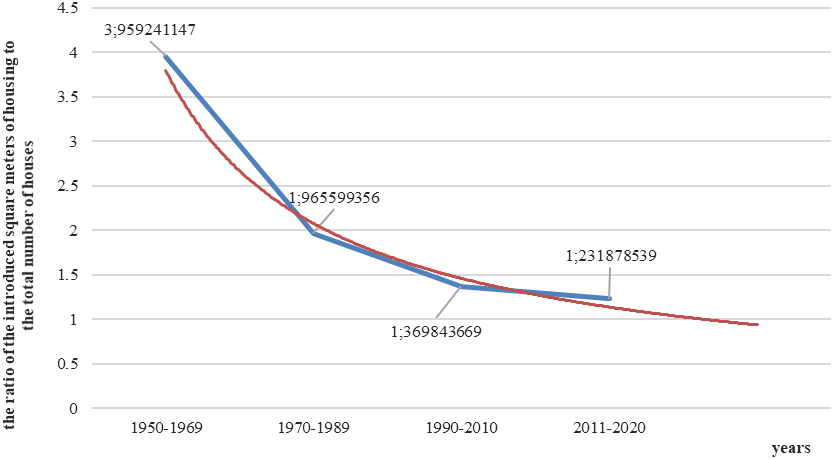
As can be seen from the trend line in Figure 3, a comparison of the increment in the number of square meters being built in combination with a decrease in the number of houses being built is expected soon. This figure can be described as an illustration of the possibility of extensive development of residential development in the city. As can be seen from Figure 3, the extensive potential is almost exhausted. This means that the supply on the market will only be limited, raising housing prices. This situation is related to several factors:
- The land resource has been exhausted, which allowed to buy land for the construction of an apartment building;
- The main part of the development occurred in the period 1950-1989;
- A large number of illegally-erected apartment buildings that are subject to demolition, according to a court decision;
- The active participation of the Prosecutor's Office of the Krasnodar Territory in the field of supervision of compliance with the project documentation and the actually constructed object alarms investors.
Additionally, the dynamics of the housing construction coefficient was analyzed. Approximately 0.8 sq. m. per 1 person will be built every year (Figure 4).
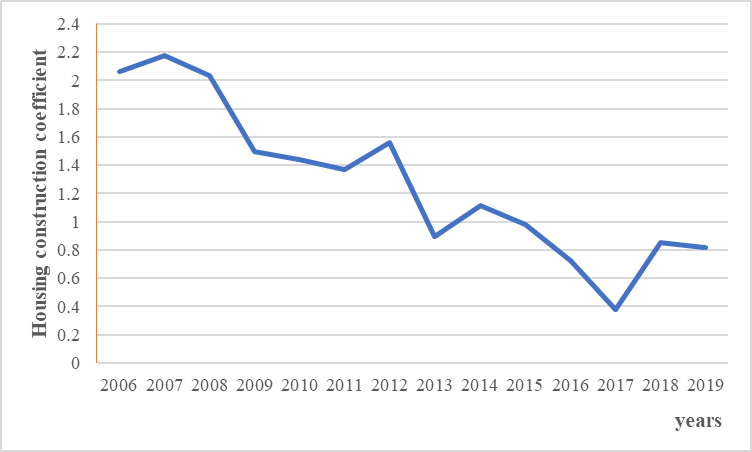
As can be seen from Figure 4, the level of housing security (the total stock of residential real estate divided by the total population) is steadily falling. According to Rosstat, the total real estate fund divided by person is 10 sq. m. per person, according to the website "Housing and communal Services Reform" 16 sq. m. per 1 person.
It is worth noting that there is a steady trend of increasing the cost of a square meter of housing in the city, on average the price per square meter increased by 22% year-on-year in the period 2019-2020. The dynamics of rental housing shows a smaller price increment of about 2 times (11.1%), which allows us to conclude that it is better to buy and sell apartments in the city than to rent them out.
Findings
The study conducted a comparative analysis of the labor market and real estate. The time period was taken from 2013-2021. The choice of such a period of time is due to the need to assess the impact of the Winter Olympics in Sochi on its further sustainable development. During the time period, data were taken on the average salary, the average price per 1 square meter of living space. Then these data were presented in the dynamics of increments of values. That is, the data for the next year was divided by the data for the past year. As a result of the analysis, Figure 5 was constructed, which shows the dynamics of price growth per 1 square meter and average wages in the city of Sochi.
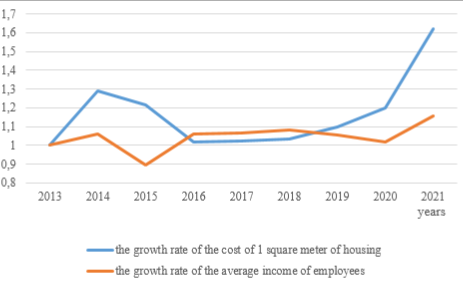
As can be seen from Figure 5, only in the period from 2016 to 2018, the growth rate of wages outpaced the growth rate of the cost per square meter. In 2014-2015, when the economic crisis came in Russia, citizens' incomes fell sharply, but the cost per square meter also decreased, while the rate of decline in the cost per square meter was more serious. However, starting in 2019, when the main gentrification processes began in Sochi, the cost per square meter began to increase sharply. So, in 2019, the growth rate of the cost per square meter outpaced wage growth by 4%, in 2020 by 17%, and in 2021 by 40%.
In the current situation, local self-government bodies of the city are recommended to take measures to support young people in terms of providing them with housing, in addition to preferential instruments introduced by the Government of the Russian Federation in 2020. It is recommended in the coming periods to increase the spending of the municipal budget on the program "Providing affordable housing for residents of the municipality of the resort city of Sochi".
Regarding the general problems of housing infrastructure development, local governments need to solve a strategic question: How will the increase in square meters of housing occur in the long term? There are two answers to this question: either wide or up. Taking into account the predominance of mountainous and foothill terrain on the territory of the municipality, which will significantly increase the cost of construction of the MKD, as well as a large amount of land assigned by the master plan to the lands of reserves controlled by the Ministry of Natural Resources and Ecology of the Russian Federation, taking into account the need to expand the territory of cemeteries, the construction of social infrastructure facilities, it is recommended to choose the option of changing urban planning standards in part of a significant increase in the maximum number of floors in the MKD. At the same time, it is recommended to carry out redevelopment of houses built in the period from 1970 to 1989.
Conclusion
Summing up, in this study, the developed definitions of sustainable development and gentrification were considered. As part of the consideration of the 11th Sustainable Development Goal, the need for competent urban planning of the city was established. In order for the city to develop within the framework of the concept of sustainable development, it is necessary that the ecosystem of the city can serve the entire population of the city without the need to use the mechanism of ecological debt. As part of the review of the publications of foreign researchers, it was found that there is a natural limit to the development of the city, expressed in the created transport infrastructure, water resources. In the condition of a large migration flow, it is necessary to change the urban planning policy. The importance of housing market development as one of the main forces influencing sustainable development was noted by foreign researchers. At the same time, it is important to determine the directions of such development. As part of the formation of a mechanism for managing changes in such an economic system as a city, aimed at changing the economic system towards sustainable development, the city of Sochi was considered as an example. The city of Sochi is experiencing strong gentrification processes. The difficult terrain and large-scale extensive development of the city during the Soviet period created conditions for the exhaustion of land resources for the construction of housing and social infrastructure at the present time. The factor of increasing demand for housing in the city of Sochi from a large number of migrants only aggravates the situation of local residents. It can be concluded that conditions have been created for local residents under which it cannot be said that their life proceeds within the framework of the concept of sustainable development. As part of the solution to the problem, a mechanism for forming a strategy for sustainable development of the city based on the analysis of the labor market and real estate was proposed. Within the framework of the recommendations, it was proposed to expand support for young people and measures were taken to change urban planning norms in terms of significantly increasing the maximum number of floors in the MKD. At the same time, it is recommended to carry out redevelopment of houses built in the period from 1970 to 1989.
References
Cooke, S., & Behrens, R. (2017). Correlation or cause? The limitations of population density as an indicator for public transport viability in the context of a rapidly growing developing city. Transportation Research Procedia, 25, 3003-3016. DOI:
Glaeser, E. L., Luca, M., & Moszkowski, E. (2020). Gentrification and Neighborhood Change: Evidence from Yelp. NBER Working Paper No. w28271. DOI:
Gutiérrez, M., & Kahhat, R. (2022). Assessing the limits to the growth of urban stocks in areas with horizontal growth constraints. Resources, Conservation and Recycling, 181. DOI:
Jinhui, L., Qing, I., Wei, G., & Chen., W. (2019). The Impact of Consumption Patterns on the Generation of Municipal Solid Waste in China: Evidences from Provincial Data. International Journal of Environmental Research and Public Health, 16(10), 1717. DOI:
Kauškale, L., & Geipele, I. (2019). Sustainable Development of Real Estate Market and its Assessment Opportunities: Case Study of Latvia. European Journal of Sustainable Development, 8(1), 375-400. DOI:
Mensah, J. (2019). Sustainable development: Meaning, history, principles, pillars, and implications for human action: Literature review. Cogent social sciences, 5(1). DOI:
Municipal statistics. (2022). Official website: https://rosstat.gov.ru/munstat Retrieved 25 May, 2022.
Official website of the Housing and Communal Services Reform Assistance Fund. (2022). Retrieved on 25 May, 2022 from official website: https://fondgkh.ru/
Prices for apartments in new buildings in Sochi. (2022). Retrieved on 25 May, 2022 from company official website: www.realtymag.ru/krasnodarskiy-kray/sochi/novostroyka/prodazha/prices
Sheikhnejad, Y., & Yigitcanlar, T. (2020). Scientific Landscape of Sustainable Urban and Rural Areas Research: A Systematic Scientometric Analysis. Sustainability, 12(4), 1293. DOI:
Shilina, D. C., & Stepanova, N. R. (2019). Renovaciya, redevelopment, revitalizaciya i dzhentrifkaicya gorodskogo prostranstva [Renovation, redevelopment, revitalization and gentrification of urban space]. Fundamental research, 12(2), 285-289. https://fundamental-research.ru/en/issue/view?id=784
Copyright information

This work is licensed under a Creative Commons Attribution-NonCommercial-NoDerivatives 4.0 International License.
About this article
Publication Date
29 August 2022
Article Doi
eBook ISBN
978-1-80296-126-3
Publisher
European Publisher
Volume
127
Print ISBN (optional)
-
Edition Number
1st Edition
Pages
1-496
Subjects
Economics, social trends, sustainability, modern society, behavioural sciences, education
Cite this article as:
Borodin, S. N. (2022). Identification Of Sustainable Development Trends Through Real Estate And Labor Market Analysis. In I. Kovalev, & A. Voroshilova (Eds.), Economic and Social Trends for Sustainability of Modern Society (ICEST-III 2022), vol 127. European Proceedings of Social and Behavioural Sciences (pp. 47-55). European Publisher. https://doi.org/10.15405/epsbs.2022.08.7

